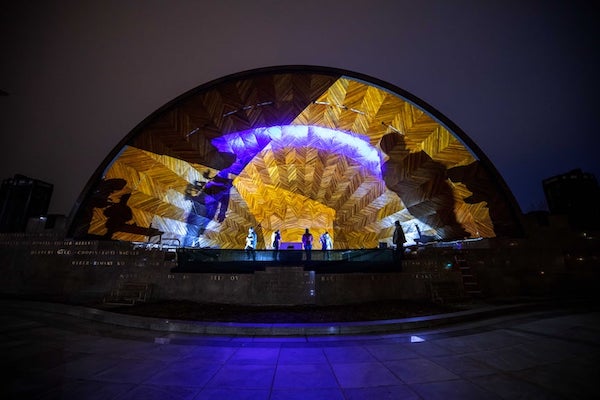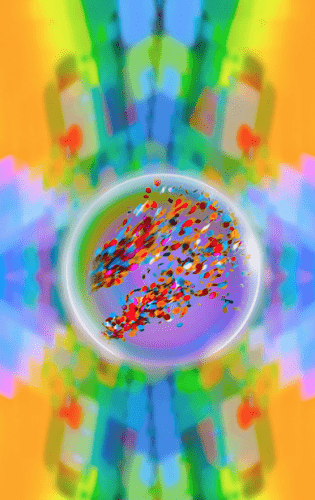Visual Arts Review: Two Public Art Projects in Boston — Provocative Visual Expressions of the 21st Century
By Mark Favermann
Steeped in technology, nontraditional public art is about sparking conversations about visuals as well as playing with contemporary aesthetic perspectives.

Hatched/Breaking through the Silence, a Light/Sound Performance by Maria Finklemeier. Source: MF Dynamics.
Public art is very different from studio art. The artist is not creating art for themselves, but expressly creating work for the public with particular attention to the environment where it will be placed. All of the issues of formal design generated by architecture and engineering come into play with public art. This is problem-solving writ large, going well beyond aesthetics: no detail is too small and no technical question can be comfortably ignored.
In recent decades, public art has morphed into two distinct formats. The first takes a traditional direction, such as monuments, memorials, and civic statuary. It features conventional representation: the war memorial, symbolic soldiers, likenesses of famous people and historical or metaphorical figures. Abstract forms strongly strive for the self-consciously poetic. Permanent public art of this type is constructed of durable, easily maintained, and resilient materials meant to withstand the worst effects of nature (wind, rain, snow, extreme heat, etc.) as well as very human vandalism.
And then there is a type of public art that is often highly interactive (changes due to viewer movement or action) or is dedicated to reflecting a specific community and its space. This approach encompasses a wide range of electronic or digital art, including performance art, digital art, video, animation, specialized lighting, video, projection art (aka digital mapping), augmented reality, virtual reality, music, and sound. Often several media forms are interwoven together.
Steeped in technology, nontraditional public art is about sparking conversations about visuals as well as playing with contemporary aesthetic perspectives. This is art that comes from not only trained fine artists, but from technology engineers, software developers, and curators. The broadening of the creative horizon encourages increased access to cutting-edge technology, drawing on the widening possibilities for visual experience today and in the future.
Recently, two outstanding technically based art projects have been introduced to the City of Boston. One is at the Boston Cyberarts Gallery; the other is at the Charles River Esplanade. While the Boston Cyberarts Gallery interior (located above the Green Street MBTA Station in Jamaica Plain) remains closed due to COVID-19, the organization has cleverly organized a series of exhibitions that can be seen from outside the gallery. Currently, an interactive exhibit by new media artist Anne Spalter, In the Future Everything Will Be Perfect, is being hosted in the large galley’s large windows. It is an exercise in visual expression that salutes the potential for a substantially better future. Images reminiscent of crystal balls float over large video screens. When viewers come closer to the images, the hope is that they will be inspired by the festive, celebratory vitality of the colorful images. Boston Cyberarts founder and executive director George Fifield was recently named one of 25 Creative Revolutionaries by the international public art organization CODAworx. He joins a lineup of artists and pioneers whose diverse works serve as mirrors of our world through the use of new technological tools and new materials to foster creation of artwork that facilitates empathy, engagement, and a sense of place.

Confetti Still SQ by Anne Spalter, Source: Boston Cyberarts.
Anne Morgan Spalter is a digital mixed media artist and academic who founded Brown University’s and RISD’s digital fine arts programs in the ’90s. She is the author of The Computer in the Visual Arts (Addison-Wesley, 1999). Her art, writing, and teaching reflect her long-standing goal of integrating art and technology. Spalter’s artwork is in collections throughout the US, Europe, and the Middle East, as well as at the Albright-Knox Art Gallery in Buffalo, NY, the Rhode Island School of Design Museum in Providence, RI, and London’s Victoria & Albert Museum.
The Esplanade Association is huzzahing its 20th anniversary via a spectacular multiple-sensory winter illumination at Riverside Park’s iconic Hatch Shell, where the July 4th Boston Pops Concerts take place. The performance/exhibition piece Hatched: Breaking through the Silence, is a four-week light and sound experience that successfully cuts through the pandemic doldrums.
The art is a 15-minute visual and sound performance created by Boston-based multimedia artist Maria Finkelmeier of MF Dynamics. The project was exactingly tailored for the 80-year-old Art Deco amphitheater. The show takes place nightly — beginning at 5 p.m. and recycling every 20 minutes until 9 p.m. — and viewers are invited to access the synchronized soundtrack on their smartphones while watching the changing illuminations. The work will run through February 21 and was made possible by collaborations with the DCR, LuminArtz, and Epson.
Maria Finkelmeier was named a “one-woman dynamo” by the Boston Globe and Boston’s Best 2018 “Creative Catalyst” by the Improper Bostonian. A percussionist, composer, public artist, educator, and arts entrepreneur, she has created large-scale multimedia events in public spaces from Cincinnati to Sweden, with several locations in Boston, including Fenway Park, Charlestown Navy Yard, and Harvard’s Arnold Arboretum. Fusing music, narrative, and collaboration in unexpected places, she has fashioned entire works out of found, nontraditional sounds. In the process, Finkelmeier has transformed iconic structures into percussive playgrounds. She’s previously been commissioned by the National Parks Service, the Illuminus Festival, and Boston Center for the Arts, as well as several other festivals. She has toured internationally as a solo, chamber, and orchestral percussionist. She is an associate professor at Berklee College of Music.
By the way, founded in 2015, LuminArtz is the unsung nonprofit hero of transforming spaces around Massachusetts. Its stated mission is to help cities and towns thrive by integrating creative arts into all aspects of civic life. The goal is to use creativity to inspire and unite communities and stimulate local business. By recognizing the critical resource of local artists, they mobilize collaborative partners across institutions and sectors. Their favorite tools are light art installations and festival environments. Under the leadership of its imaginative and entrepreneurial director, Lyn Burke, LuminArtz projects have included 2019-20’s Light Up the Night throughout New Jersey’s Essex County, 2017’s Solar Forest in Cambridge, 2017-2019’s Illuminus in various locations around Boston, 2019’s Set Sail in Salem, and 2019’s Sea Lights at the Cape Ann Museum in Gloucester.

Hatched/Breaking Through the Silence, a Light/Sound Performance by Maria Finklemeier. Source: MF Dynamics.
After the Black Death (1347-1351), the Renaissance began, and after the Spanish Flu (1918-1921), the Roaring Twenties commenced. It will be fascinating to see what forms creativity will take after the COVID-19 pandemic. These two projects, with their focus on the transformative power of light, their enthused reveling in brightness and color, suggests that some of the public art to come will be dedicated to casting today’s darkness and shadows out of our minds.
An urban designer and public artist, Mark Favermann has been deeply involved in branding, enhancing, and making more accessible parts of cities, sports venues, and key institutions. Also an award-winning public artist, he creates functional public art as civic design. The designer of the renovated Coolidge Corner Theatre, he is design consultant to the Massachusetts Downtown Initiative Program and, since 2002, he has been a design consultant to the Red Sox. Writing about urbanism, architecture, design and fine arts, Mark is Associate Editor of Arts Fuse.
Tagged: Anne Morgan Spalter, Boston Cyberarts Gallery, LuminArtz, Maria Finkelmeier

Very nice about exciting new electronic art in public spaces, Mark. I look forward to visiting it all. When cataloging public art, let’s not forget outdoor murals, which The Mural Ats Project in Philadelphia has done so brilliantly for forty years, and the late, incomparable Christo. I would also suggest that fireworks, though ephemeral, are also valuable public art.
Thanks for a thoughtful look at what’s going on right around us, right now. Will definitely see both.